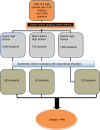Prevalence and associated factors of myopia among high school students in Gondar town, northwest Ethiopia, 2016
- PMID: 30214355
- PMCID: PMC6095558
- DOI: 10.2147/OPTO.S120485
Prevalence and associated factors of myopia among high school students in Gondar town, northwest Ethiopia, 2016
Abstract
Introduction: Myopia is an important cause of correctable visual impairment and preventable blindness worldwide. Prevalence rates are approximately 20%-35% among the older teenage population globally. It has a medical burden of pathologic complications such as maculopathy and glaucomatous optic neuropathy. High school students experience high-performance and study pressures in the preparation for the final national examination. As a result they are exposed to excessive near work and indoor activities. They are also ignored for regular screening.
Objective: To determine the prevalence and associated factors of myopia among high school students in Gondar town, Ethiopia.
Methods: An institution-based cross-sectional study was conducted on 498 high school students with systematic random sampling method from April 18 to April 29, 2016, in three full-cycle high schools (9th-12th grades). A standardized structured questionnaire, Snellen acuity chart, pinhole, retinoscope, trial case lenses, pen torch, and direct ophthalmoscope were used to collect data.
Results: A total of 495 study participants were included, and they had a mean age of 17.48±1.59 years. The prevalence of myopia was 11.9% (95% confidence interval [CI]: 10.2, 17.9). Family history of myopia (adjusted odds ratio [AOR]=8.08 [95% CI: 4.30, 15.16]), school being private (AOR=2.88 [95% CI: 1.02, 8.11]), longer time spent for near work (AOR=2.89 [95% CI: 1.12, 7.43]), longer time spent partaking in indoor activities (AOR=4.32 [95% CI: 1.69, 10.99]), shorter near working distance (AOR=3.06 [95% CI: 1.33, 7.06]), lack of outdoor sport activities (AOR=2.27 [95% CI: 1.05, 4.90]), use of visual display units (AOR=2.81 [95% CI: 1.30, 6.10]), and abnormal ocular findings (AOR=6.69 [CI: 3.43, 13.03]) were found to be independently associated with myopia.
Conclusion: The prevalence of myopia was 11.9%. Family history for myopia, school being private, longer time spent partaking in indoor activities, shorter working distance, lack of outdoor sport activities, use of visual display units, and presence of abnormal ocular findings were positively associated with myopia.
Keywords: Ethiopia; Gondar town; high school students; myopia.
Conflict of interest statement
Disclosure The authors report no conflicts of interest in this work.
Figures
References
-
- Goss DA, Grosvenor TP, Keller JT, Marsh-Tootle W, Norton TT, Zadnik K. Optometric Clinical Practice Guideline Care of the Patient with Myopia. St. Louis, MO: American Optometric Association; 1997. p. 243.
-
- Bar Dayan Y, Levin A, Morad Y, et al. The changing prevalence of myopia in young adults: a 13-year series of population-based prevalence surveys. Invest Ophthalmol Vis Sci. 2005;46(8):2760–2765. - PubMed
-
- Pan CW, Ramamurthy D, Saw SM. Worldwide prevalence and risk factors for myopia. Ophthalmic Physiol Opt. 2012;32(1):3–16. - PubMed
LinkOut - more resources
Full Text Sources
Other Literature Sources
Research Materials
Miscellaneous


